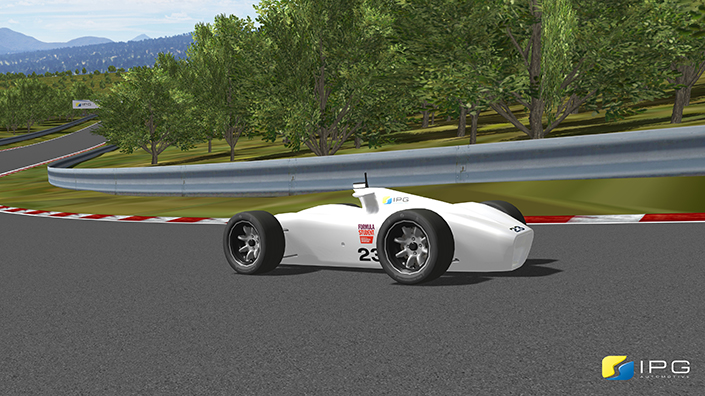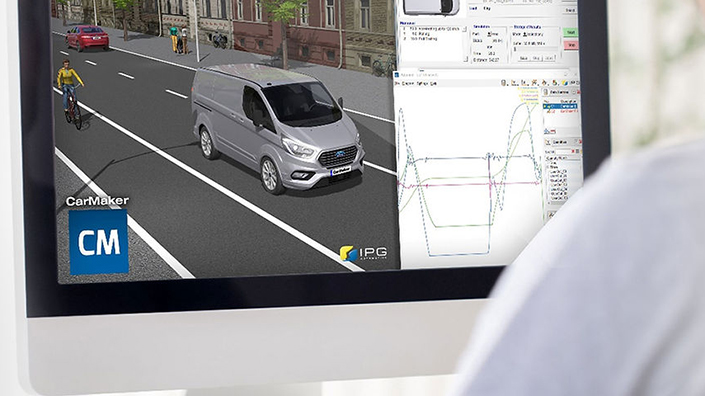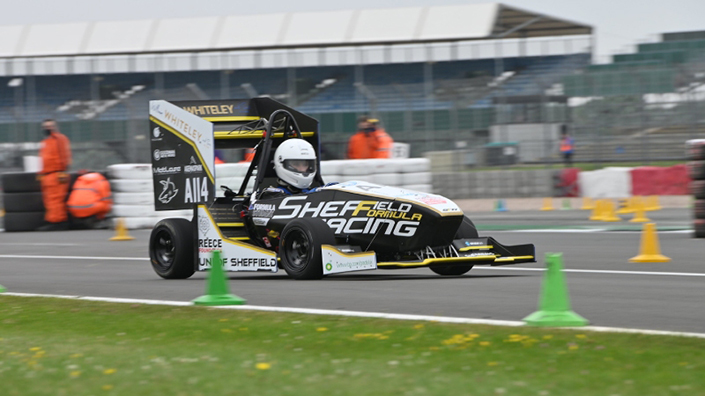The gradual shifts towards electric vehicles (EVs) and autonomy reflect changes in the wider automotive sector, as it adapts to ‘net zero’ targets and aims for continuing profitability in an uncertain future.
It is also being enabled by advanced technology that previous generations of automotive engineers could hardly have dreamt of. One such example is CarMaker from German-headquartered IPG Automotive, a virtual prototyping tool that enables simulated testing of systems throughout each design and development stage.
Previously just used in the concept class, free licences of the software are now available for all participants. For universities that have always built and raced petrol cars, the tool can offer vital support and assistance as students explore all-electric powertrains or driverless technology.
Using CarMaker during Formula Student also gives young engineers vital experience with professional software, which has already transformed development cycles for car manufacturers.
Simulation loop
CarMaker allows engineers to build up a full vehicle model, progressing through increasing levels of fidelity throughout the development. Users start with basic models early in the design process, with feedback from the software assisting design and architecture decisions.
Gradually, the virtual vehicle becomes more complex, with the addition of suspension models for example. It even allows manufacturers to introduce new technology in the virtual world – active suspension with some proprietary algorithms, for example. The performance of that system can be tested in virtual manoeuvres, with engineers tweaking and adding code if needed. Then, the updated code can be added to a real electronic control unit (ECU), which can be electronically tested within the ‘simulation loop’.
“As far as the ECU is concerned, there's a real car around it – that real car is just virtual,” says Will Snyder, sales engineer at IPG Automotive UK.

If it performs as expected, the ECU could then be connected to a physical suspension system, which is then run on a ‘rolling road’ surrounded by a projected virtual environment.
“The idea is you can validate your product and your development at every stage throughout the project, rather than waiting ‘til you get to the final prototype and then trying to put all these different systems in different parts of the car together,” says Snyder.
“At that point everything goes wrong… you expect them to come together and work perfectly, and the reality is that doesn't happen. The more you can do step-by-step, the more reliable your development – and the quicker it is, because you can do it in the virtual world.”
Combining simulated environments with virtual prototypes and real components allows developers to test many more parameters than physical testing, all at a faster pace. Scenarios can include roads or tracks, pedestrians, traffic lights, street furniture, other traffic, a virtual driver and more.
“The beauty of it is you can run 50,000 tests, rather than three,” says Snyder. “If the weather is bad, or… the sun is just at the wrong point, you can programme that in, you can have those levels of excessive light, or not enough light, or rain, and see what the impact is on your sensors.”
With tight timeframes and ongoing university work to manage, such extensive repeatability means Formula Student teams can carry out far more tests in the virtual world, honing their vehicles before on-track events at Silverstone.
Edge cases
The use of virtual environments is a key part of the Ford-led Vivid (Virtual Vehicle Integration and Development) project, in which IPG is working alongside the automotive giant as well as testing specialist HORIBA MIRA, Loughborough University and the Institute of Digital Engineering. The project aims to develop digital engineering tools to promote ‘model-based systems design and verification for virtual product development’.
Simulation can be particularly useful for firms like Ford that have a “ridiculous” number of model derivatives, says Elliot Hemes, managing director at IPG Automotive UK.
“There are many, many, many hundreds, probably thousands in fact, of derivatives of the Transit,” he says. “Whether that's fully laden, roof box, no roof box, long wheelbase, short wheelbase, high roof, low roof, all those different combinations.
“To physically validate them all, and test them all, is just not feasible. Ford aren't going to build that many prototypes, and they’re certainly not going to have time and the number of engineers stood around.”

Ford is leading the Vivid project
After 119 years of operation, you might be forgiven for thinking that Ford has all the experience it needs to develop new vehicles in a confident and timely fashion. The issue often comes from the introduction of new software or features, however. While each derivative might not be a ‘step change’ in vehicle architecture, as the number of interacting systems such as ECUs, anti-lock braking systems (ABS) and other technologies increase, the vehicle becomes more and more complicated, making simulation an appealing choice.
The approach helps identify the ‘edge cases’ that need focusing on, says Hemes. By pushing certain parameters to their extreme, engineers can identify potential issues and redirect development efforts.
Vivid partner HORIBA MIRA has developed an ‘Intelligent Lab’ that brings together environmental emulation, hardware-in-the-loop (HiL) and digital twin creation, to allow hundreds or even thousands of RDE (real driving emissions) tests within CarMaker in a matter of hours. Dynamic modelling and HiL are used to create an accurate digital twin model of the powertrain, which is then combined with CarMaker to generate reliable predictions of vehicle efficiency and emissions.
The process allows engineers to rapidly identify and resolve areas of concern, reportedly cutting development and validation time by more than 70% and ‘eliminating’ requirements for expensive vehicle prototypes. The method is also applicable to all types of EV systems.
A new formula
Software such as CarMaker can be just as useful for Formula Student teams as it is for huge multinational manufacturers. The whole package is available to university groups, which use it for things like working out cars’ final drive ratios – rather than going to a test track for three days with 10 different sprockets, hoping for different weather conditions and tyre temperatures, all those parameters can instead be tested in simulation.
“We’re trying to coach the teams into making data-driven decisions on how they design their vehicles, rather than just saying ‘I want to do a single-seater race car with that design, this, this and this,’” says chief judge Dan Jones.

Winners from the University of Sheffield at FS2021
IPG has sent out over 250 licences to more than 100 teams for the 2022 competition, and it provides fortnightly webinars to help students get the hang of it. There’s a virtual prototype of the FS-AI vehicle, allowing teams to get into it quickly, and it can be particularly helpful for teams shifting from petrol to electric. It allows students to “experiment and muck around with things, to try and get an idea of what's good and what's bad,” says Hemes.
“It’s a very capable tool,” says Jones. It is particularly useful for teams aiming to maximise their scores across multiple events, he adds, including sprints and endurance tests. “It’s quite a complex optimisation problem, to define what gives you your best overall event score… CarMaker enables up-front simulation of the multiple design trade-offs and continued optimisation once those hardware decisions are fixed.”
As with many other elements of Formula Student, using CarMaker can be extremely useful experience for the world of work.
“Our idea is that when they come out of university, they should have good appreciation of how real-world software packages are going to be used,” says Snyder. “You also want to prepare them for the real world, where you're not going to do finite element analysis by maths, you’re going to have a programme that does it for you.”
Want the best engineering stories delivered straight to your inbox? The Professional Engineering newsletter gives you vital updates on the most cutting-edge engineering and exciting new job opportunities. To sign up, click here.
Content published by Professional Engineering does not necessarily represent the views of the Institution of Mechanical Engineers.